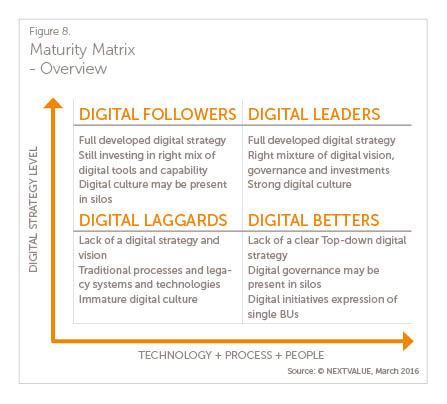
In the latest CIONET research on the state of digital transformation in Europe, conducted by CIONET and NextValue, a lot of emphasis is put on understanding the digital maturity of European companies.
To compare the digital maturity of European companies, we have put them into a matrix where the “What”, the Digital Strategy, poses as Y-axis, and the “How”, the different stages of implementation of Process, People and Technology, is represented by the X-axis.

Based on the survey responses, the companies can now be grouped according to their maturity levels:

What we should expect from our clusters in a perfect world is a at least a linear relation between a defined strategy and its implementation, the more detailed and “perceived” the former, the more efficient and effective the latter. As business history tend to remind us, this is far from the real case.
At the end of our analysis, only two quadrants are populated, though with different levels of digital maturity, Digital Leaders and Digital Laggards:
Digital Laggards (47% of total panel) represents the second most consistent cluster in our Maturity Matrix. However, it is possible to drill down our analysis of Digital Laggards into further clusters, as depicted in Table 2:
Digital Leaders (53%) constitutes the majority of our panel, nevertheless it is, at the same time, a multifaceted cluster. The “real” Digital Leaders, champions in both strategic definition and implementation of digitalization, are composed only by the 17% of the total panel and form the so-called sub-cluster of Established Leaders.
With this, we can now determine which practices and focus areas digital leaders have in common, and in which they differ with Digital Laggard:

Established Leaders are focused on training to build a “digital culture” within their organisations (45%). However, searching and retaining digital talents, is the second most rated option, along with the Creation of Centre of Excellence (22%).
Established Leaders focus their attention both on giving proper training to their current employees and, secondly, on investing into new resources with digital capabilities. This trend has to be taken into consideration, since without digital skills success in the new digital economy is, as properly stated by Wired in one of its articles, “essentially as trying to win a gun-fight armed only with a knife”.
Digital Leaders are also investing in Centres of Excellences, or Digital Teams, to promote a Digital Transformation strategy in the 22% of cases, against a 13% signalled by total panel. A Centre of Excellence is a working group, which operates separately and in parallel to the company’s main business, focused on rewarding and innovative projects. The creation of dedicated digital teams is an option chosen by different organisations to cultivate new capabilities. However, these projects can become successful only if these capabilities are actually integrated into the company’s core business. As it is known, skills integration could often prove to be a challenge.
The full report is now available here!
Contact frederic@cionet.com for any additional question!
This research is a joint initiative of CIONET and NextValue.
No Comments Yet
Let us know what you think